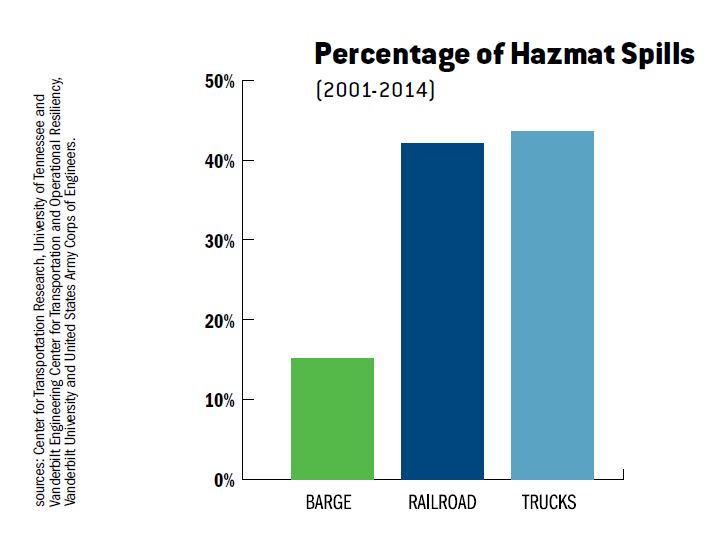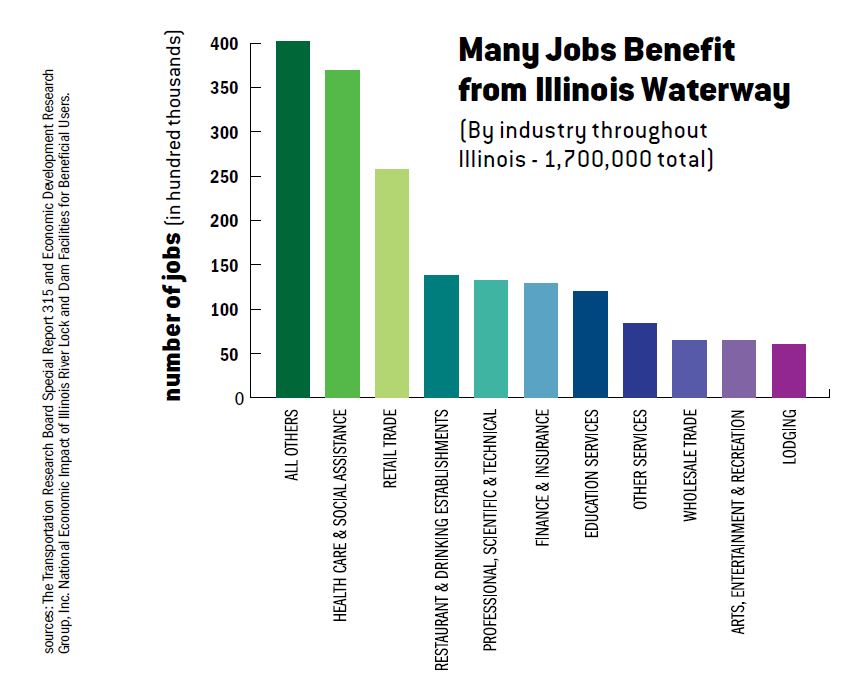Expiration dates are included on products such as food and drink, batteries and medicine to indicate they may not be safe or reliable to consume after the indicated time. Often, risks can be associated with using an expired product.
The same could be said for waterway locks and dams. While they don’t come with an expiration date, they do come with an engineered lifespan of about 50 years. Many locks have been in use for close to 80 years, with minimal improvements, due to a lack of funding. Locks in use beyond their lifespan can increase the risks of a failure, raising safety and reliability concerns.
Failure is Far-Reaching
When a lock is down due to poor conditions, the impact can be far-reaching, extending well beyond just delays for commodity transportation on the waterway.
For example, the lock chambers on the Illinois River are approximately 110-feet wide by about 600-feet long, with a height overall that ranges widely to enable a minimum nine-foot draft for tow vessels and barges to navigate safely. If they fail, not only would barge traffic likely come to a halt, entire communities could be left cleaning up the possible aftermath of a flood.
According to the report “Modal Investment Comparison: The Impact of Upper Mississippi River Lock and Dam Shutdowns on State Highway Infrastructure,” across the region, a one-season shutdown of Lock and Dam 25 on the Mississippi River north of Alton would result in re-routing between 9.1 million and 12.4 million tons in agricultural goods, or 367,000 and 489,000 truckloads. It would cost as much as $283 million to move these loads by truck. Damage to roadways from these movements could cost states up to $28.8 million.
The report, released in October 2017, was based on research conducted by the Mid-America Freight Coalition, which focuses on planning, operation, preservation and improvement of transportation infrastructure in the Midwest. Whether it is added truck traffic resulting in roadway congestion, increased wear on highways or a larger demand for truck drivers, the report confirms entire regions could be affected by a lock failure.
System Demand is Significant
Illinois waterways are the most economical, efficient and environmentally friendly mode in the region for transporting cargo, according to industry statistics. The Illinois Department of Transportation (IDOT) estimates Illinois has 1,095 miles of navigable waterways that either border or pass through the state. The U.S. Army Corps of Engineers Rock Island District documents more than $23 billion in commodities shipped on Illinois’ inland waterways annually.
So why doesn’t inland marine freight get more attention and more money to fix the locks and dams in disrepair? It is a not question of “if” there will be an operations or maintenance issue on the Illinois Waterway, but “when.” According to Robert Ginsburg, Ph.D., director at the Center on Work and Community Development, there are several reasons:
- Fragmented, incompatible and incomplete data across public and private stakeholders
- No coordinated industry support
- No highly visible, consistent strategic freight vision
- Not being integrated into a complete intermodal transportation system
ISA Partners with Industry for Solutions
Knowing that coordinated industry support is a missing link, the Illinois Soybean Association checkoff program (ISA) recently hosted an Illinois Waterway System Futures Forum in Springfield, Ill. Waterway stakeholders in attendance included the chemical industry, port districts, U.S. Army Corps of Engineers and port authorities.
The meeting focused on waterway transportation growth projections, maintaining a robust and reliable waterway system, characterizing financing options and agreeing on consensus points for future collaboration. Discussion also included evaluations of future waterway needs and advanced conversations to ultimately result in prioritizing waterway system enhancements.
“Waterway improvements benefit everyone,” says Stan Born, ISA director and soybean farmer from Lovington, Ill. “It is important we all unite and work together to find consensus that results in the right solutions to fix the problem.”
Born adds ISA realizes one of the best ways to ensure Illinois’ waterway infrastructure needs are included in important discussions is to present a consensus position on priorities that everyone can agree on across the various stakeholders.
“You start with the ‘why,’” says Born, “and then talk about the ‘what,’ to get to the ‘how.’ Tell the whole story.”
The following consensus points were developed by ISA and industry stakeholders, based on several government, university and private economic studies:
- The Illinois Waterway is the most economically efficient way to transport bulk commodities.
- The Illinois Waterway reduces congestion on the highway and railway
- The Illinois Waterway is the most environmentally sound way to transport bulk commodities
- The Illinois Waterway is at risk because of the significant backlog of deferred maintenance and lack of adequate federal funding.
- The Illinois Waterway system benefits a significant portion of the United States.
- The Illinois Waterway benefits more than 1.7 million jobs in multiple economic sectors throughout Illinois.



ISA Leads Future Dialogue
Following the Illinois Waterway System Futures Forum, ISA continues to lead conversations with stakeholders, developing a coalition to facilitate infrastructure improvements on the Illinois Waterway. Together the stakeholders will pursue increased funding for the state’s waterways, as reliability of infrastructure is crucial for Illinois soybeans to remain competitive internationally.
Illinois leadership is important because Illinois was the top soybean-producing state in 2017. USDA’s National Agricultural Statistics Service (NASS) annual crop production report estimated Illinois farmers raised 611.9 million bushels of soybeans on more than 10 million acres last year. With approximately 60 percent of these soybeans sold through export channels annually, multiple modes of transportation must be used to get them to their final destinations.






 and then
and then